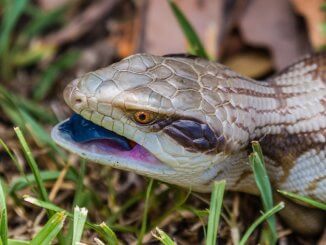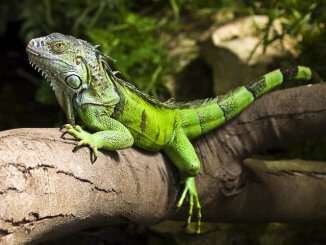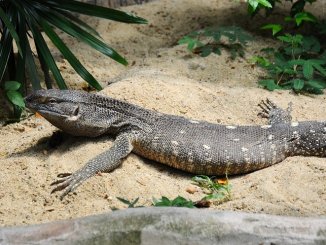The Timor monitor is a species of dwarf monitor that grows up to two feet long, with a dark grayish, greenish, or black body bearing irregular bands of golden-yellow eye spots; its small size and calm, if shy, temperament makes it suitable to keep in captivity.
The Timor monitor is native to the tropical jungle on the island of Timor in the Indo-Australian Archipelago.
Despite its small size, it requires a large, stimulating habitat due to its high activity levels, its need for hiding places, and great intelligence.
Timor Monitor Overview
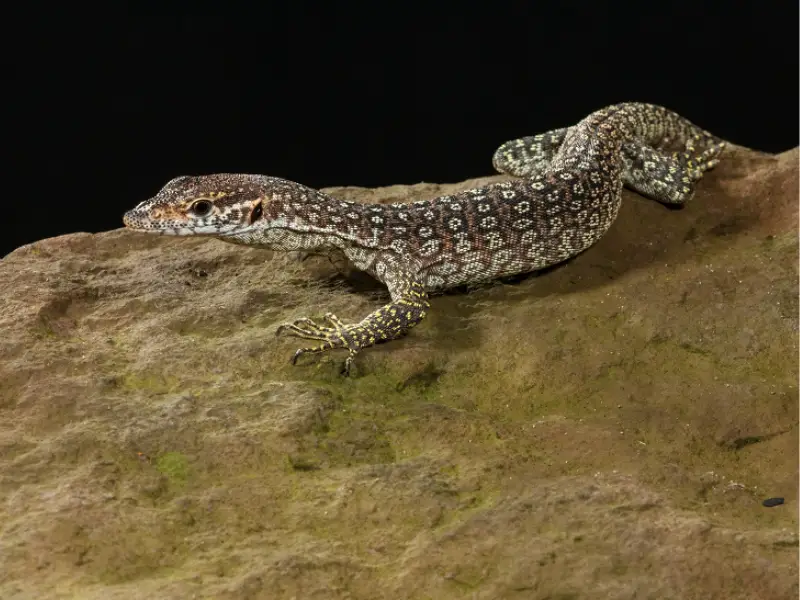
| Common name | Timor Monitor, Spotted Tree Monitor |
| Scientific name | Varanus timorensis |
| Natural habitat | Hot and humid jungles with plenty of hiding places. The Timor monitor comes from Timor, an island shared between Indonesia (West Timor) and the sovereign state of Timor-Leste (East Timor). |
| Adult size | 16 to 24 inches (up to 30 inches in captivity) |
| Average lifespan | 10 years (can attain 15 to 20 years in captivity) |
| Diet | Insectivorous |
| Housing | A 240-gallon enclosure |
| Experience | Intermediate |
Origin
Timor monitors (Varanus timorensis) are found on the island of Timor, shared between Indonesia and the independent nation of Timor-Leste.
In the wild, they live in hot, humid jungles with plenty of trees to climb and foliage to hide in. Where forest has been cleared, they have adapted to climbing rock walls and hiding in crevices. They enjoy soaking and playing in the water.
Appearance and Behavior
The Timor monitor has a typical monitor appearance with a sleek body, long neck, and elongated head. Its prehensile tail can account for as much as two-thirds of its length. It has five long, sharp-clawed toes, sharp teeth, and a long tongue.
Timor monitors are black, dark gray, or dark green, with irregular, transverse bands of golden-yellow, or occasionally bluish, eye spots; these bands become rings on the tail. Their coloring is duller on their flanks, and their bellies are straw-colored, with numerous small, dark speckles.
Male and female Timor monitors look extremely similar. They are a diurnal, arboreal species, sleeping at night and hunting, basking, and climbing trees by day. They are timid, hiding at any sign of danger.
Like all monitors, they are highly intelligent.
Size and Lifespan
Newly hatched Timor monitors are five inches long and grow rapidly to their adult size of 16 to 24 inches.
They can live up to 20 years in captivity, meaning keeping one is a long-term commitment.
Temperament
The Timor monitor is solitary, shy, and nervous. It needs plenty of hiding spots to feel secure. They are best kept on their own. Never keep males together, as they will fight.
Wild-caught specimens are highly nervous of humans, whereas those reared in captivity will tolerate some handling. They are highly unlikely to attack people with their teeth, claws, or tails but, like other monitors, may defecate on a perceived threat. They will try to escape from danger and hide.
Housing Timor Monitor Lizards
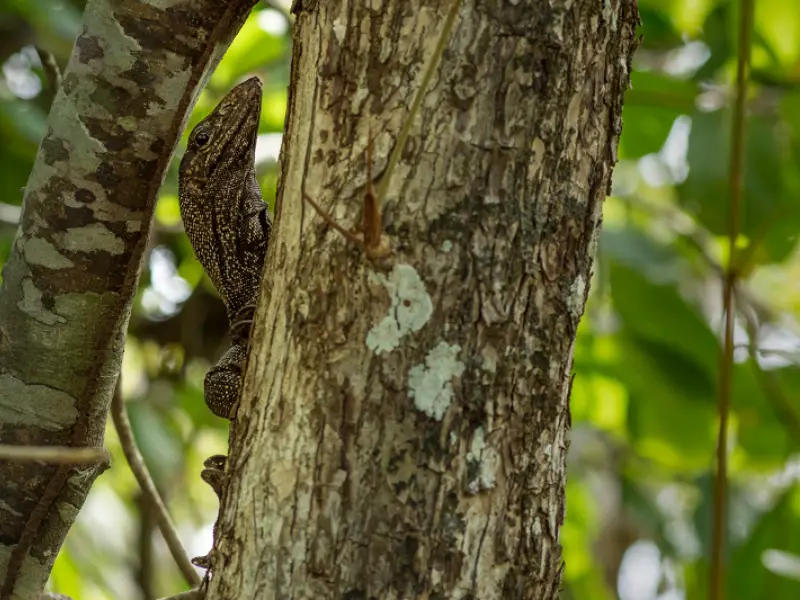
A Timor monitor will do best if kept in a habitat that mimics its natural environment of a hot, humid, leafy jungle.
Enclosure Size
Although hatchlings can be kept in 20-gallon tanks, starting them in an adult enclosure is best. The minimum enclosure size for an adult Timor monitor is 240 gallons; vertical space is essential to this species, including plenty of things to climb on.
Lighting
Use a timer to give a Timor monitor 12 hours of light and 12 hours of darkness, year-round. Provide UVB lighting to avert health problems, housing the UVB light in a reflector on the same side of the enclosure as the heat lamp. Timor monitors also benefit from plant grow lights.
Temperature and Humidity
A Timor monitor requires daytime temperatures between 79 and 90°F and nighttime temperatures between 71 and 75°F, with smooth transitions to prevent chilling. Provide a daytime basking spot (a flat stone or sturdy branch) with temperatures between 120 and 130°F.
The best heat source for the basking spot is two halogen heat bulbs, which mimic natural sunlight. Keep these about one foot from the basking surface. Measure temperatures inside the enclosure with a digital probe thermometer.
They enjoy humidity between 70 and 85%, peaking around 90%. Mist with an automatic misting system twice daily when the lights are off (around dawn and dusk). If additional humidifying is required, run a cool mist humidifier controlled by a humidistat at night.
Use only distilled, disinfected water, and measure humidity with a digital hygrometer.
Substrate and Decoration
Hatchlings can be kept on paper toweling or astroturf. Juveniles and adults need jungle mixes or a mix of mulch, coco peat, small-grained gravel, and plenty of jungle soil. The substrate should be at least a foot deep, as Timor monitors love digging. A layer of chemical-free leaf litter helps enrich their environment.
Provide plenty of braided vines and branches for the monitor to climb; ensure that branches are sturdy to prevent them from collapsing. Supply lots of cork rounds, live or artificial plants, and hiding places to make it feel secure.
Give the monitor a large tub of water to soak and play in. Ensure it’s hidden behind the vegetation, as a Timor monitor won’t use a pool it doesn’t feel safe in.
Cleaning
Replace the substrate completely every three to four months. Remove poop, urates, and contaminated substrate daily. Change the water in their tub whenever it becomes soiled, as reptiles often defecate in their water, and scrub the container with a reptile-safe disinfectant.
Remove the Timor monitor before cleaning.
Timor Monitor Care
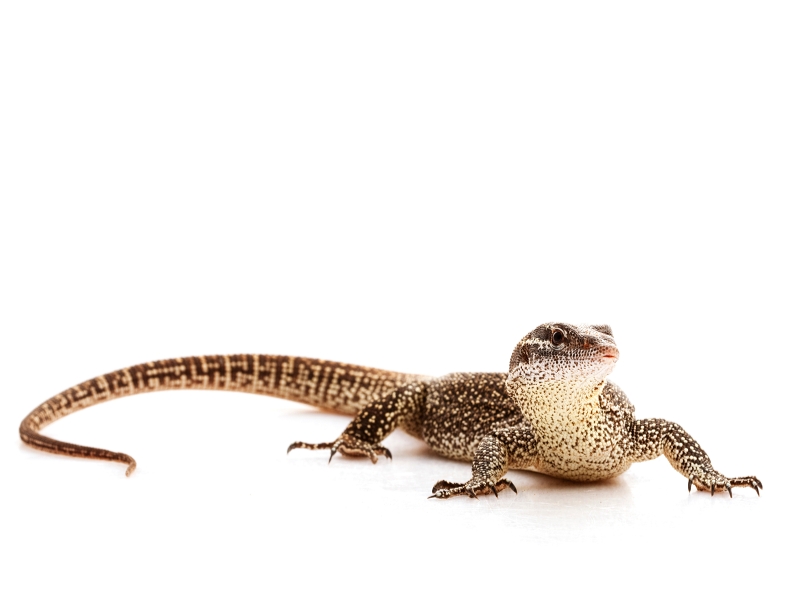
Timor monitors are pretty hardy, and replicating their natural environment will help them to thrive.
Food and Water
Timor monitors are insectivorous, so supply a Timor monitor with a wide variety of insects, preferably live ones. Gut load the insects to ensure their nutritional value. Feed the monitor in the morning four times a week, although larger adults should be fed about three times per week.
Offer hatchlings and juveniles as much as they can eat in a day and subadults and adults as much as they can eat in five to ten minutes.
Grasshoppers, crickets, roaches, fly larvae, mealworms, other beetle larvae, adult darkling beetles, silkworms, and centipedes are all good foods for a Timor monitor. At most meals, especially for youngsters, dust with vitamin and calcium supplements.
An adult Timor monitor can have a pinkie mouse, feeder guppy, or raw egg once a month, but beware of overfeeding to prevent obesity.
The Timor monitor will get the water it needs from its water tub.
Handling
Although Timor monitors bred in captivity can cope with some handling, too much will stress them. Handling them for short periods from when they are hatchlings and feeding them with feeding tweezers can help habituate them. They are not recommended for beginners or children.
Common Health Issues
Timor monitors are hardy but can suffer from obesity, calcium deficiency, digestive problems, or infections. Careful feeding, calcium supplements, UVB lights, keeping their enclosure clean, keeping them in warm, humid conditions, and not handling them too much help avert these issues.
Breeding
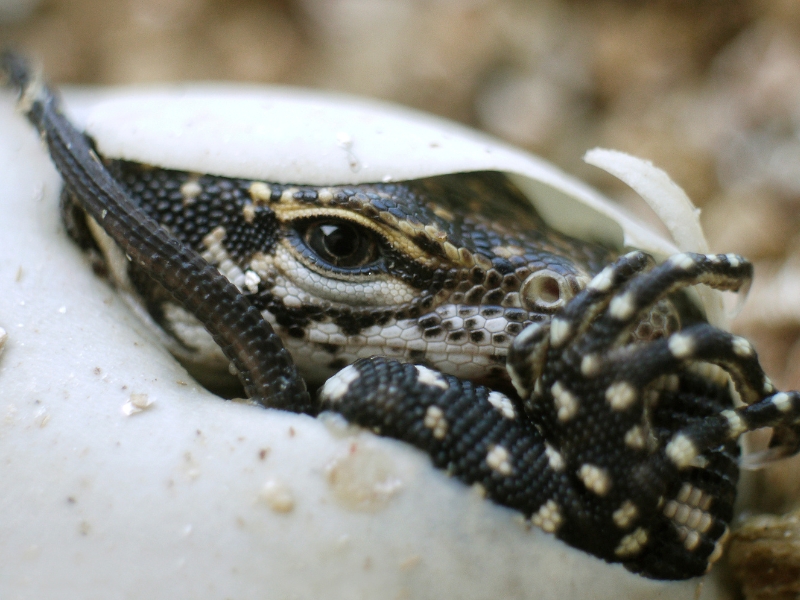
In the wild, the onset of the rainy season, with the associated temperature decrease, triggers mating. By lowering the temperature inside the enclosure and increasing humidity, you may be able to get captive Timor monitors to mate.
Successful mating results in the female being gravid for four to six weeks and then laying five to 11 eggs in a pit dug in the ground. Depending on the average temperature, the eggs take around 90 to 120 days to hatch.
Timor monitors are around five inches long at hatching but grow quickly. They attain sexual maturity around the age of five to six years.
Choosing and Buying a Timor Monitor
Look for a registered breeder, and expect to pay around $200 for a Timor monitor.
Reptile owners with a reasonable amount of experience looking for a small, beautiful monitor lizard that doesn’t need (or want) much human interaction will probably enjoy a Timor monitor.
On the other hand, those looking for a more human-friendly dwarf monitor should try an ackie or mulga monitor instead.

